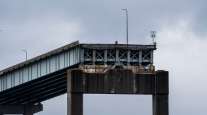ARTBA Study Finds 58,000 US Bridges to be 'Structurally Deficient'

Nearly 10% of the country’s bridges – 58,495 out of 609,539 – were considered structurally deficient last year and needed repairs, the American Road and Transportation Builders Association reported Feb. 18.
The total represents 2,574 fewer bridges than the more than 61,000 in 2014, according to ARTBA, which represents the design and construction industry. The association reviewed Transportation Department records for its study. More than 63,000 bridges were structurally deficient in 2013, the group found.
Cars, trucks, buses and emergency vehicles cross deficient bridges more than 200 million times a day. If placed end to end, the deficient bridges would stretch 1,340 miles, from New York City to Miami.
“I think it is something to still be concerned about, just because of the sheer number of bridges classified as structurally deficient,” ARTBA Chief Economist Alison Black said. “It’s just such a big problem.”
The five states with the most deficient bridges were Iowa with 5,025, Pennsylvania with 4,783, Oklahoma with 3,776, Missouri with 3,222 and Nebraska with 2,474.
The five states with the biggest share of deficient bridges were Rhode Island at 23.2%, Pennsylvania at 21%, Iowa at 20.7%, South Dakota at 19.7% and Oklahoma at 16.4%.
Deficient bridges aren’t necessarily falling down, but they are in need of repair. Bridges are rated on a scale of zero to nine, with a top score meaning excellent condition. Scores of four or below are classified structurally deficient.
Part of the problem is maintaining aging bridges. Of the 250 most heavily traveled bridges that need repairs, 85% were built before 1970 with the creation of the interstate highway system.
The most heavily traveled bridges that need repairs include:
• In California, several Interstate 405 bridges in Los Angeles.
• In Pennsylvania, several I-95 bridges in Philadelphia.
• In Maryland, several I-95 bridges.
• In New York, the Brooklyn Bridge.
• In Washington, D.C., Arlington Memorial Bridge.
Congress approved a $305 billion, five-year highway bill in December. This was important because the federal government contributes about half the funding for highways and bridges.
But the concern is that state departments of transportation will begin slowing down major projects in four years unless a permanent funding stream is found, Black said.
“Congress basically put a Band-Aid on it,” Black said. “It’s going to take major new investments by all levels of government to move toward eliminating the huge backlog of bridge work in the United States.”
The Transportation Department estimated a $115 billion backlog in repairs for bridges rated structurally deficient or functionally obsolete.
Congress has refused to increase the federal gas tax of 18.4 cents per gallon since 1993. But 16 states have raised gas taxes in the past three years.
The Institute on Taxation and Economic Policy counts nine states seriously considering motor fuel tax increases: Alabama, Alaska, California, Hawaii, Indiana, Mississippi, Missouri, New Jersey and South Carolina.
“Most of the gas tax increases under discussion right now would help restore at least some of the purchasing power they lost while being frozen in time for as long as 20 years or more,” said Carl Davis, research director at the institute.
The current pace of investment would take 21 years to replace or upgrade all the deficient bridges.
“It’s a challenge,” Black said.




